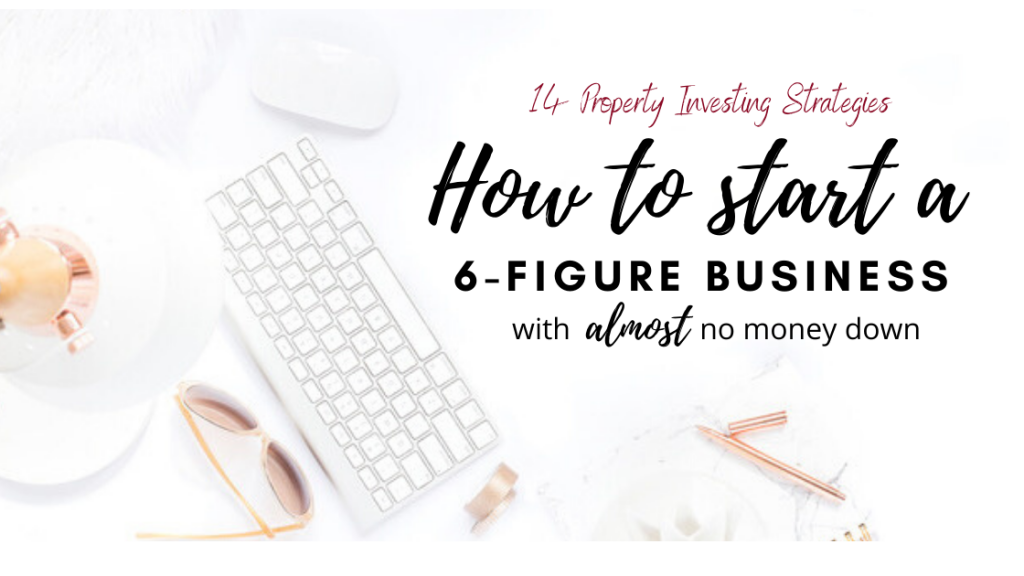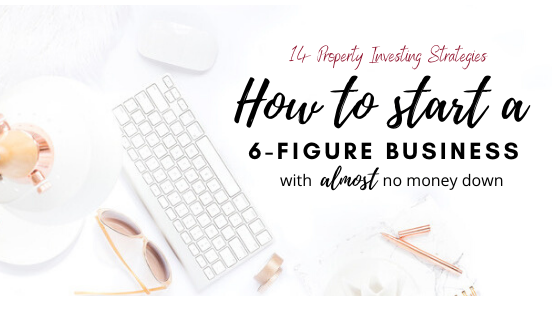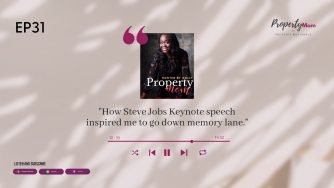On this episode we’ll be finishing up on the 14 ways to make money in property with little or no money down – if you haven’t listened to last weeks episode please check it out as I covered the 1st 7 strategies and this episode will be covering the rest of the 14.
To set up the context, I mentioned last week that the number 1 fundamental principle is understanding the difference between OWNING and CONTROLLING. Owning requires you BUILD UP the initial cash, intellectual capital or funds to acquire the property or Asset while controlling requires you BUILD UP your network of people who own the asset and then leverage this to market related services that you can earn from. This does require you get out of your comfort zone and start to let people know what you are doing, let them know of your progress, if you’re going on any training courses, your first deal and build up that track record and confidence so that they begin to see you as the point of contact for the service you’re developing as your niche.
So going on to rest of the 14 ways to make money in property with almost no money down….

STRATEGY EIGHT: DEAL PACKAGER FOR COMPLEX BUY TO LET DEALS
Again This is separate from strategy 7 in that these deals require more in-depth knowledge to make the financials stack up (with the strategy no 7 where you’re packaging rent to rent deals, the initial investment for your deals are considerably lower and there are less costs or structures to worry about so you’re able to get them to stack up quite easily and sell them on .
With this strategy where you’re packaging more complex BTL deals, you have more at stake as the deal sizes are much higher and therefore you will need to really understanding what makes up a good deal and where to source these deals. It also helps if you understanding what development strategy could work for a location (for instance if you sourced a property that would be suitable for a HMO conversion you would might be able to earn more from the deal because it would be more valuable to an investor than if you sourced for just a single let property with less value.
The more successful deal packagers I know understand some of the fundamentals of a good deal such as ROI which is the return on investment on the deal or Rental yields which gives them a better chance at selling them on to investors (especially when it’s not in a major city or well know location). if you can demonstrate it’s in high growth area or has great rental demand it will appeal to more buyers of your deals. Each investment strategy will have its own specific criteria and you can charge anything up to 5% of the deal you’ve brokered depending on the value you’ve been able to secure.
STRATEGY NINE: LEASE OPTION DEAL MAKER
Lease options In simple terms, is a type of contract used in both residential and commercial real estate. In a lease-option, a property owner and prospective tenant agree that, at the end of a specified rental period for a given property, the renter has the option of purchasing the property. You become a dealer or broker by connecting potential buyers who can’t get on the property ladder but want to own a home some day in the future with the landlords or developers wanting to get rid of their properties. The more motivated they are the easier it is to set up the option agreement. The upside for the seller or landlord is that they don’t have to do much maintenance and upkeep because the tenant has essentially bought the property in the future at a price set today so they have the responsibility to take care of it. In addition if anything happens to the tenant circumstances, they can choose not to exercise their option and can walk away from the deal. You can make money by charging both parties a fee to broker the deal (& it can be anything up to 10%).
STRATEGY TEN: INTERIOR DESIGN FOR LANDLORDS, CORPORATE OR OVERSEAS OWNERS
I specifically mentioned landlords as opposed to home owners because in my experience it’s a lot easier to source and style up a house or flat that is for rental instead of styling persons own home which can be quite a specialist field.
A lot of landlords don’t always see the value in doing this themselves nor do they have the interest, so selling this service is always quite lucrative as there is now a gap in the market especially brought about by the fact that tenants are becoming more house proud with the onset of the media age where they want to show off their homes so there is now increased pressure for landlords to almost “stage” the property’s to appeal to the higher quality tenants. Also, with the SA and HMO tenants there is also a requirement for staging the homes so you can always find business.
You could also develop Interior design services for overseas owners and corporate tenants as they also require “on the ground” project management which they might not always have a local contact for. With this strategy You can either charge your client a fee for each room you style or charge a percentage of the overall budget and also earn commission on the products you source which can be really lucrative as some vendors offer 40% discounts to their trade clients so a really good stream of income.
STRATEGY ELEVEN: HOME & RefURBishment SERVICES BROKER
For this you’ll need to develop a good set of contacts which will become your Power Team Black Book of handymen, service providers, plumbing, builders and specialist services to offer to your clients. you can initially start this as an ad hoc service with the aim to eventually expand to property managing services for variety of homeowners and landlords. Most estate agents that provide this service charge a fee on every single service provider recommended through them. In this market, there is always work being done to refurbish or fix or transform a home and setting up a refurbishment and home services company where you contract out these services can be a steady source of side income. Building the contact list of home owners and providing quick and reliable services can very quickly ramp up as you’re able to charge anywhere from 10-30% for work you contract out.
STRATEGY TWELVE: RENT TO ROOM RENTAL or HOUSE SHARE STRATEGY
So this is where you rent a property for yourself to live in but instead of getting a smaller property for just yourself, you upsize the property and obtain consent from your landlord so you can rent out the extra rooms to house sharers and lodgers. It is indeed the first step towards Rent-to-rent and the only difference really is that you also live in the property. At the very least, you’ll have zero rent to pay as this will have been structured within the pricing of the other rooms I’ve known this to be more successful in student towns or cities where people can earn a side income from advertising the other rooms and setting up lodging agreements.
However, this is also where your investment and risk profile starts to increase as opposed to the previous strategies where you only had set up and marketing costs which came to couple hundred pounds, in this case you have to deposit the initial rent or bear the risk of default if any of your lodgers fail to pay. Depending on your location, your initial deposit and rental could start off in the thousands, but if structured well In a good location with good room rental demand they are a good source of income so for people who were going to rent a property anyway or if you already have access to a property where there are extra rooms and it can provide additional income.
STRATEGY THIRTEEN: RENT TO RENT – SERVICED ACCOMMODATION OR HMOS
The famous R2R strategy whereby you take control of the property from the owner by renting it and then you sublet the property (with consent) to other tenants or guests for a profit. A well known strategy is to use the guaranteed rent method to lock in the rent for a few years and then find tenants to rent to – these could be single let tenants of single family household or HMO houses of multiple occupancy let (where you have multiple tenants usually over 3 households living in the same house with individual room contracts). R2R Serviced accommodation was a great strategy prior to Covid 19 as it had really great returns, so once this blows over I expect it to be back but with a few changes to adapt to any post Covid 19 rules. R2R strategy really works since you can acquire a property starting with just about £5000-£10000 and you’re able to double that investment within a year of operation and can scale up to generate even more solid income.
And finally…….(geez)
STRATEGY FOURTEEN: JOINT VENTURE WITH INVESTOR FINANCING
My absolute favourite strategy and if done well you can build up a portfolio of partly owned property or good cash returns from the investments with very little of your own money in and win-win for everyone. Setting up a joint venture with someone with the capital or surplus cash means you will need to demonstrate good financial management and understanding of property investing.
It is best used for buy to sell deals or flipping (buy, refurb to add value and sell on ) or can also be used for BTL deals. Your value add is 2-fold:
1) helping people realise they could be doing more with their cash than locking it up in a low or non interest bearing security by sourcing a great deal that has good profit built in as a relatively safe investment with much higher yields.
2) your sweat equity in managing the entire process since you’re invested in the entire deal lifecycle and more importantly (and preferably) your funding source is uninterested in getting involved and just looking for safe passive income which you can guarantee against the property.
You do all the hard work up front but for most people this is the quickest way to develop a good income, and build a portfolio and develop a thriving property business.
BONUS STRATEGY: WRITING AND CREATING PROPERTY JOURNEY BLOG
I must say that all of these strategies will require you either start a blog, podcast or Youtube channel or Social media platform to engage with your audience and so watch this space as we will be developing training on how to adapt current technology to grow your online property business. In today’s world (especially with the onset of Covid 19) not being online is like a business’s death sentence and we can already see the trends in the number of high street shops shutting down so writing and creating a property journey blog – educating people about what you’re doing and about existing trends in your chosen strategy is vital and is the lifeblood of your business so I’ve included this as a bonus because it should run along side all the above strategies.
Now i know it’s a lot to digest, so for more information do sign up with your email address and I’ll forward you the 14 WAYS ebook so you can go through it in more detail and decide what works for you.
All the best!







